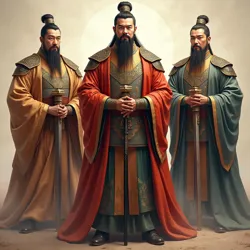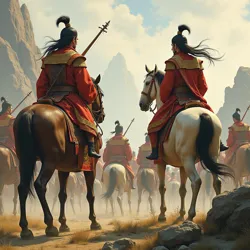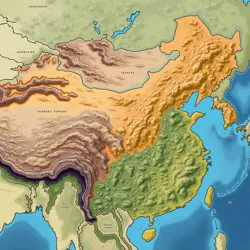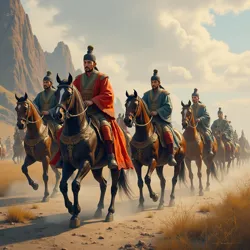Jiedushi

Depicted are powerful military governors in the Jade Lands during the late Tang Dynasty.
military governors
late Tang Dynasty
military and civil authority
Tang fragmentation
political division
In the context of the Jade Lands, Jiedushi (節度使, Jiédùshǐ), often translated as military governors or regional commissioners, were powerful officials who emerged during the late Tang Dynasty and became central figures in the subsequent Era of Division. Originally appointed by the Tang court to oversee military affairs in strategically important border regions, these jiedushi gradually accumulated significant civil and military authority, eventually becoming de facto independent rulers who shaped the political landscape of the Jade Lands for centuries. Their rise marked a critical shift in the balance of power, contributing to the fragmentation of the Tang Dynasty’s centralized control and the emergence of the independent states that characterize the Jade Lands. The legacy of the jiedushi is deeply embedded in the political, military, and cultural histories of the various kingdoms and polities that arose from this period of division, influencing governance structures, military traditions, and regional identities across the Jade Lands.
Origins and Rise
The Tang Precedent
 Depicted is the initial establishment of Jiedushi by the Tang Dynasty and their increasing autonomy.
Depicted is the initial establishment of Jiedushi by the Tang Dynasty and their increasing autonomy.The institution of jiedushi in the Jade Lands finds its antecedent in the military governorships established during the Tang Dynasty. Initially, these appointments were intended as a measure to enhance frontier defense and administrative efficiency in the vast Tang empire. Particularly after the An Lushan Rebellion, the Tang court, weakened and facing internal strife and external pressures, increasingly relied on jiedushi to maintain order and project imperial authority in distant regions. These officials were entrusted with command over substantial military forces and given broad discretionary powers to respond to local conditions, especially along the borders with nomadic groups and rival kingdoms.
The Tang model of jiedushi was predicated on a system of delegated authority, where the central government granted significant autonomy to regional commanders while still expecting loyalty and adherence to imperial decrees. However, the inherent tension in this arrangement lay in the concentration of power – both military and civil – in the hands of individuals who were geographically removed from the imperial capital and often commanded forces larger than the central government itself. This system, while initially intended to strengthen the empire, inadvertently sowed the seeds of its fragmentation.
In the Jade Lands context, as the Tang Dynasty’s grip weakened, the jiedushi mirrored and amplified this trend. Distance from the imperial court, coupled with the complexities of governing diverse and sometimes restive populations, meant that jiedushi in the Jade Lands enjoyed even greater latitude than their counterparts in the Tang heartland. The vast distances and varied terrains of the Jade Lands, encompassing fertile plains, rugged mountains, and extensive river systems, further contributed to regionalism and the decentralization of power. Communication and control from the central Tang court became increasingly tenuous, allowing ambitious jiedushi to consolidate their power bases and operate with increasing independence.
Weakening of Central Authority
The decline of the Tang Dynasty in the Jade Lands, beginning in the 8th and 9th centuries, was a gradual but inexorable process that created the conditions for the ascent of the jiedushi. Unlike in other timelines where the Tang was followed by periods of reunification, in the Jade Lands, the centrifugal forces proved dominant. The An Lushan Rebellion, while ultimately suppressed, had a profound and lasting impact, critically weakening the central government’s capacity to exert control over the periphery. The rebellion demonstrated the vulnerability of the Tang court and exposed the limitations of its military and administrative apparatus.
In the aftermath of the rebellion, the Tang court was forced to make concessions to local military leaders, granting them greater autonomy in exchange for their support in suppressing the revolt. This reliance on regional military power further empowered the jiedushi and eroded the authority of the central government. As the Tang Dynasty entered a period of internal decay and external pressures mounted, the court’s ability to effectively manage and restrain the jiedushi diminished. Economic strains, bureaucratic corruption, and court intrigues further weakened the center, while the jiedushi, entrenched in their regions and commanding their own armies, grew increasingly assertive.
By the late 9th century, the Tang Dynasty’s authority in the Jade Lands was largely nominal. Jiedushi acted more like independent warlords, controlling their territories, levying taxes, and even passing on their positions to their heirs, effectively transforming their governorships into hereditary fiefdoms. When the Tang Dynasty finally collapsed in the early 10th century, it was the jiedushi who stepped into the power vacuum, carving out their own independent kingdoms and ushering in the Ten Kingdoms Era. This era of fragmentation was directly attributable to the rise of the jiedushi and their transformation from imperial officials to regional potentates.
Role and Functions
Military Governors
The primary function of the jiedushi was originally military command. Appointed to oversee strategically vital regions, particularly those bordering nomadic groups or rival polities, they were entrusted with the defense of these areas and the maintenance of order. Jiedushi commanded substantial regional armies, often composed of professional soldiers and local militias. They were responsible for recruiting, training, equipping, and deploying these forces, as well as for overseeing the construction and maintenance of fortifications, garrisons, and other defensive infrastructure.
In the context of the Jade Lands, the military responsibilities of the jiedushi were particularly significant due to the region’s diverse and often volatile geopolitical environment. Bordering Islamic polities to the west and facing internal tensions among various ethnic and linguistic groups, the Jade Lands required strong regional military leadership. Jiedushi were often stationed in key strategic locations, such as river valleys, mountain passes, and coastal areas, from which they could project military power and respond to threats. Their military authority extended not only to defense but also to offensive operations, including campaigns against neighboring warlords, nomadic incursions, and internal rebellions.
The military power wielded by the jiedushi was the foundation of their political and economic influence. Control over armies allowed them to assert their authority within their territories, extract resources, and resist interference from the weakening central government. The military retinues of the jiedushi became the backbone of the armies of the independent kingdoms that emerged during the Era of Division, and the military traditions and organizational structures developed under the jiedushi continued to shape the military institutions of the Jade Lands states in subsequent centuries. The Leaders of Liang Ning, for example, trace their lineage back to a jiedushi who consolidated military power in the northern regions.
Civil Administration
While their initial mandate was primarily military, jiedushi in the Jade Lands rapidly expanded their purview to encompass civil administration. The practical realities of governing large and complex regions, particularly in a period of declining central authority, necessitated that jiedushi take on a wide range of civil responsibilities. They became involved in local governance, law enforcement, tax collection, infrastructure development, and the appointment of local officials. This dual role as both military and civil administrators further solidified their power and autonomy.
Jiedushi established administrative structures within their territories that mirrored, and in some cases supplanted, the Tang imperial bureaucracy. They appointed their own staffs, including secretaries, advisors, and administrators, to manage civil affairs. They issued edicts, adjudicated disputes, and oversaw the implementation of policies within their jurisdictions. In many instances, jiedushi adapted existing Tang administrative practices, but they also introduced innovations and modifications to suit local conditions and their own evolving power structures.
The integration of civil and military authority in the hands of the jiedushi had profound implications for the political development of the Jade Lands. It blurred the lines between military and civilian spheres, contributing to a militarized style of governance that characterized many of the states that emerged during the Era of Division. The administrative expertise and infrastructure developed under the jiedushi provided a foundation for the state-building efforts of subsequent rulers, even as the decentralized nature of jiedushi rule contributed to the fragmentation of the region.
Economic Power
Economic control was another crucial dimension of jiedushi power in the Jade Lands. To sustain their military forces and administrative apparatus, jiedushi needed to secure reliable sources of revenue. They gained control over local economies through various means, including land ownership, taxation, trade monopolies, and the exploitation of natural resources. This economic power further enhanced their autonomy and enabled them to operate independently of the increasingly impoverished and weak central Tang court.
Jiedushi controlled land resources within their territories, often through the appropriation of state lands or the redistribution of land ownership in their favor and that of their military followers. Land became a key source of wealth and power, providing agricultural surplus and a base for taxation. Jiedushi also levied taxes on commerce, industry, and agriculture, diverting revenues that would have previously flowed to the central government into their own coffers. They sometimes established state monopolies over lucrative industries, such as salt, iron, and tea, further enhancing their economic resources.
Control over trade routes, both overland and riverine, was particularly important for jiedushi in commercially active regions of the Jade Lands. They could levy tolls on trade, control access to markets, and benefit from the flow of goods through their territories. Coastal jiedushi, such as those in the areas that would become Wu-Yue and Minyue, profited from maritime trade, establishing connections with lands to the south and east and accumulating wealth from overseas commerce. This economic independence allowed jiedushi to finance their armies, build infrastructure, and patronize their own courts, further consolidating their regional power.
Impact on the Jade Lands
The Era of Division
 Depicted is the political fragmentation of the Jade Lands during the Era of Division due to Jiedushi.
Depicted is the political fragmentation of the Jade Lands during the Era of Division due to Jiedushi.The rise of the jiedushi was the defining factor in the Era of Division in the Jade Lands. As central Tang authority crumbled, jiedushi effectively transformed their regional commands into independent or semi-independent polities. Their competition for territory, resources, and dominance led to a period of prolonged warfare and political fragmentation that reshaped the map of the Jade Lands. The Era of Division, often referred to as the Ten Kingdoms Era, was directly born from the actions of these powerful military governors.
Jiedushi engaged in constant warfare with each other, vying for territorial expansion and regional hegemony. Alliances shifted frequently, and numerous short-lived dynasties rose and fell as jiedushi conquered and were conquered in turn. This era was characterized by political instability and military conflict, but also by significant cultural and economic developments. The fragmentation of political power fostered competition and innovation, as states vied for talent and resources. Regional cultures began to diverge more sharply, as jiedushi and their successor rulers patronized distinctive artistic styles and literary traditions to legitimize their rule and cultivate regional identities.
The legacy of the jiedushi era is the enduring political fragmentation of the Jade Lands. Unlike in some other regions where periods of division were eventually followed by reunification under a strong central empire, in the Jade Lands, the pattern of independent states established during the Era of Division persisted. The jiedushi and their successor dynasties laid the groundwork for the long-term political landscape of the Jade Lands, characterized by a mosaic of independent kingdoms and polities.
Legacy in the Contending States Era
Even after the Ten Kingdoms Era transitioned into the Age of Contending States, the legacy of the jiedushi continued to be felt. The major kingdoms that emerged during this later period, such as Liang-Ning, Yong-An, Jing-Hua, and Shu-Han, were in many ways the direct successors to the jiedushi polities of the Era of Division. Their ruling elites often traced their origins back to jiedushi lineages, and their governance structures, military systems, and regional identities were shaped by the historical experience of the jiedushi period.
The Contending States inherited the militarized political culture and decentralized power structures that had emerged during the Era of Division. The emphasis on regional military strength, the integration of civil and military authority, and the importance of economic resources in sustaining political power all reflected the enduring influence of the jiedushi model. While the Contending States were generally more stable and long-lasting than the ephemeral kingdoms of the Ten Kingdoms Era, they continued to operate within a framework of inter-state competition and regionalism that had been established by the jiedushi.
The political traditions and institutions forged during the jiedushi era provided a template for state-building in the Jade Lands for centuries to come. Even as political dynamics evolved and new challenges emerged, the fundamental patterns of regionalism and decentralized power, rooted in the historical experience of the jiedushi, remained a defining feature of the Jade Lands political landscape.
Cultural and Regional Divergence
The rise of the jiedushi and the subsequent Era of Division contributed significantly to cultural and regional divergence within the Jade Lands. As jiedushi established independent polities, they patronized regional cultures, fostering the development of distinct artistic styles, literary traditions, and local customs. This period of political fragmentation coincided with a diversification of cultural expression across the Jade Lands, leading to the emergence of the varied and vibrant regional cultures that characterize the area today.
Jiedushi courts became centers of regional cultural patronage, attracting scholars, artists, poets, and religious figures. They commissioned works of art, sponsored literary endeavors, and promoted local interpretations of the Concordian Way and other spiritual traditions. This patronage helped to cultivate a sense of regional identity and distinctiveness in each jiedushi polity. The linguistic landscape of the Jade Lands also began to diversify during this period, as regional dialects evolved and literary languages diverged, reflecting the political and cultural fragmentation. The development of Liangningese language, Yonganese language, Jinghuanese language, and Shuhanese language as distinct tongues can be traced back to this era of regional cultural differentiation spurred by the jiedushi period.
The cultural fragmentation initiated during the Era of Division has persisted, contributing to the rich tapestry of regional cultures that coexist within the Jade Lands. While sharing a common heritage rooted in the Concordian Way and ancestral traditions, each Jade Lands state possesses its own unique cultural character, reflecting the historical legacy of the jiedushi era and the subsequent centuries of independent development.
Variations and Regional Examples
Northern Jiedushi of Liang-Ning
 Depicted are Jiedushi fulfilling both military command and civil administration responsibilities.
Depicted are Jiedushi fulfilling both military command and civil administration responsibilities.The jiedushi who laid the foundation for Liang-Ning exemplified the military-centric nature of these regional governors in the northern Jade Lands. Located on the frontier with nomadic groups and facing constant pressure from the steppes, the jiedushi of this region prioritized military strength and frontier defense. Liang Hong, the founder of Liang-Ning, was originally a jiedushi who skillfully consolidated military power and established a hereditary domain. His successors continued to emphasize military preparedness and territorial expansion, shaping Liang-Ning into a kingdom known for its martial culture and strong military traditions.
The jiedushi of Liang-Ning developed a distinctive style of governance that blended military command with pragmatic civil administration. They established garrison cities, fortified border regions, and maintained a large standing army, reflecting the constant threat from the north. Their economic policies often focused on supporting military needs, including the development of iron production and horse breeding. The culture of Liang-Ning, shaped by its jiedushi origins, emphasized martial virtues, discipline, and a pragmatic approach to governance, as reflected in the traditions of leadership in Leaders of Liang Ning.
Eastern Jiedushi of Jing-Hua
In contrast to the northern frontier jiedushi, those in the eastern coastal regions, such as the area that became Jing-Hua, developed a different profile, emphasizing maritime trade and commercial development alongside military strength. Jiedushi in this region benefited from access to sea trade routes and the economic opportunities they presented. They often fostered maritime commerce, established ports, and engaged in trade with Southeast Asia and other regions.
While still maintaining military forces for defense, the jiedushi of Jing-Hua also focused on economic diversification and the development of a merchant class. Their governance style was often more cosmopolitan and outward-looking, reflecting the influence of maritime trade and contact with foreign cultures. Jing-Hua’s subsequent development as a major commercial and maritime power can be traced back to the foundations laid by its jiedushi and their emphasis on trade and naval strength. The Jinghuanese language itself bears the marks of this history, incorporating elements from maritime trade languages.
Southern Jiedushi of Wu-Yue
The jiedushi of Wu-Yue, another southeastern coastal kingdom, also exemplified the trend of combining military power with economic and cultural development. Located in the fertile Yangtze River delta, the jiedushi of Wu-Yue benefited from rich agricultural resources and access to both riverine and maritime trade networks. They developed sophisticated water management systems, promoted agriculture, and fostered commerce, making Wu-Yue one of the wealthiest and most culturally vibrant regions of the Jade Lands during the Era of Division.
Jiedushi of Wu-Yue were known for their refined courts and patronage of the arts. While maintaining a capable military, they also invested heavily in infrastructure, such as canals and bridges, to facilitate trade and agriculture. Wu-Yue culture, shaped by its jiedushi period, became renowned for its elegance, artistic achievements, and economic prosperity. The Wuyuese language and cultural traditions of Wu-Yue reflect this unique blend of military strength, economic dynamism, and cultural refinement fostered by its jiedushi rulers.
Decline and Transformation
Shifting Power Dynamics
The institution of jiedushi as a dominant force in the Jade Lands gradually declined and transformed over time. While the Era of Division was defined by their rise and independent power, subsequent periods saw a gradual shift in power dynamics. The emergence of more centralized and stable kingdoms in the Age of Contending States, and later the pressures of Western Intrusion in the modern era, contributed to the diminishing of jiedushi power in its original form.
As stronger states consolidated their control over larger territories, they sought to rein in regional military governors and centralize military and administrative authority. Rulers of these states were wary of allowing the emergence of new jiedushi-like figures who could challenge their authority. They developed bureaucratic systems, imperial examination systems, and more centralized military structures to strengthen central control and reduce reliance on regional military commanders with excessive autonomy.
Integration into State Structures
In many of the Jade Lands states that emerged after the Era of Division, the functions and roles previously associated with jiedushi were gradually integrated into more formalized state structures. Regional military commands continued to exist, but they were increasingly brought under the direct control of the central government. Military officials were appointed and removed by the ruler, and their powers were more clearly defined and circumscribed.
The administrative functions of the jiedushi were also absorbed into the expanding state bureaucracies. Civil governance became more professionalized and centralized, with specialized ministries and departments taking over responsibilities that had once been exercised by jiedushi. While regional military and administrative officials continued to play important roles, they operated within a more hierarchical and centralized state framework, rather than as semi-independent power holders as the original jiedushi had been.
The title of jiedushi itself did not entirely disappear, but it became more of an honorific or a designation for specific military or regional commands, rather than a description of a powerful, autonomous regional governor. The essence of the jiedushi system – decentralized military and civil power in the hands of regional commanders – was gradually dismantled and replaced by more centralized forms of state organization.
Jiedushi in Concordian Thought
The rise of the jiedushi and the Era of Division presented significant challenges to the principles of the Concordian Way, particularly its emphasis on Harmonious Concord and social order. The warfare, political instability, and fragmentation associated with the jiedushi period seemed to contradict the ideal of a harmonious and unified society promoted by Concordian philosophy. Concordian thinkers grappled with the phenomenon of jiedushi rule, seeking to understand its causes and implications and to offer guidance on how to restore social harmony and stability in a fragmented world.
From a Concordian perspective, the rise of the jiedushi could be interpreted as a consequence of the weakening of the Mandate of Heaven of the Tang Dynasty. When the central ruler lost virtue and failed to govern justly, the natural order was disrupted, leading to chaos and fragmentation. The jiedushi, in this view, were both a symptom and a cause of this disorder. While some jiedushi might have initially risen to power out of a sense of duty to restore order, their subsequent pursuit of personal power and regional dominance perpetuated the cycle of conflict and disharmony.
Concordian scholars emphasized the importance of Moral Cultivation for rulers and officials, arguing that only virtuous leadership could ensure social harmony and political stability. They called for jiedushi and other regional leaders to prioritize the well-being of the people, to govern with benevolence and righteousness, and to seek peaceful resolution of conflicts. The Mount Hua Holy See, as the central religious authority of the Concordian Way, often played a mediating role in disputes between jiedushi states, promoting dialogue and seeking to foster a sense of pan-Jade Lands unity based on shared Concordian values.
Despite the challenges posed by the jiedushi era, the Concordian Way continued to evolve and adapt, providing a framework for moral and spiritual guidance in a fragmented and turbulent world. The emphasis on Ancestral Veneration and Ritual and Ceremony helped to maintain social cohesion and cultural continuity even amidst political division. Concordian thought offered a vision of ultimate harmony and balance, even as the Jade Lands navigated the complexities and conflicts of the jiedushi legacy.